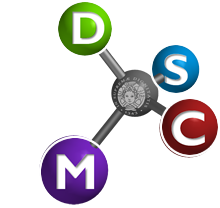
Contacts:
Supervisor(s):
Dott. Claudio Evangelisti and Prof. Fabio Marchetti
Title of the PhD project:
Design of Earth‐abundant transition metal-based electrocatalysts for sustainable electrolysis.
Abstract of the PhD project:
Although the discovery that electricity can promote the breakdown of water into dihydrogen and dioxygen has been known since decades, the use of molecular hydrogen as a large-scale energy carrier still faces numerous limitations to its mature implementation. In addition to problems related to its diffusion and use in safe conditions, a limit to the hydrolysis process is still represented by the anodic oxygen evolution reaction (OER). In fact, unlike cathodic HER (hydrogen evolution reaction) reactions that require minimum potentials, OERs provide for an exchange of four electrons (per mole of produced O2) through kinetically demanding processes that require high potentials with low selectivity. Nowadays catalysts based on Ir and Ru (and their oxides) are the most widespread ones and show excellent activities, but the scarce availability of the metallic elements, together with their high cost and the high metal loading generally required for the preparation of anodic catalyst, is certainly a technical problem that needs a quick and effective solution. This research project aims to develop a sustainable alternative to traditionally used benchmark catalysts by prioritizing the use of PGM-free electrocatalysts on an industrial scale. The final goal will to facilitate the transition towards a more mature hydrogen economy. The study will focus on synthesizing nanostructured PGM-free catalysts, including bi- or trimetallic (i.e., Fe, Co, Ni, Cu) catalysts, using innovative approaches and analyzing their electrocatalytic performances for both OER and HER reaction. A particular emphasis will be devoted to explore the correlation between the structural, morphological and textural features of the materials and their electrocatalytic performances. However, transitioning from half-cell studies to large-scale cell applications poses certain challenges that need to be addressed. Therefore, the study will be conducted at Erredue Spa industry to assess the practical applications of the synthesized catalysts. "
Publications:
• M. Pugliesi, M. Bellini, E. Pitzalis, L. Poggini, L. Capozzoli, H. A. Miller, C, Evangelisti. ACS Applied Energy Materials. 2025. DOI: 10.1021/acsaem.5c00717
• M. Pugliesi, M. Cavallo, C. Atzori, B. Garetto, E. Borfecchia, L. Donà, B. Civalleri, G. Tuci, G. Giambastiani, S. Galli, F. Bonino, A. Rossin. Advanced Functional Materials. 2024, 2403017. DOI: 10.1002/adfm.202403017
• G. Tuci, A. Rossin, M. Pugliesi, H. Ba, C. Duong-Viet, Y. Liu, C. Pham-Huu, G. Giambastiani; Catalysis for a Sustainable Environment: Reactions, Processes and Applied Technologies; 3, 45; John Wiley & Sons, 2024. DOI: 10.1002/9781119870647.ch12
• G. Tuci, M. Pugliesi, A. Rossin, C. Pham-Huu, E. Berretti, G. Giambastiani, Chemistry Select 2022, e202203560. DOI: 10.1002/slct.202203560 - Cover Picture
• X. Zhang, L. Truong-Phuoc, X. Liao, V. Papaefthimiou, M. Pugliesi, G. Tuci, G. Giambastiani, S. Pronkin, C. Pham-Huu; Journal of Material Chemistry A; 2022,10, 6153-6164. DOI: 10.1039/D1TA09519F.
• M. M. Alcaide, M. Pugliesi, E. Álvarez, J. López-Serrano, R. Peloso; Inorganics; 2022; 10(8); 109. DOI: 10.3390/inorganics10080109.
• K. V. Domasevich, P. Campitelli, M. Moroni, S. Bassoli, G. Mercuri, M. Pugliesi, G. Giambastiani, C. Di Nicola, A. Rossin, S. Galli; Inorganica Chimica Acta; 2022; 537; 120923. DOI: 10.1016/j.ica.2022.120923.
Oral communications at conferences:
...
Poster communications at conferences:
• M. Pugliesi, M. Bellini, E. Pitzalis, L. Poggini, L. Capozzoli, R. Bondi, C. D’Angelo, C, Evangelisti. IrRuW-based nanocomposite with boosted activity and stability for acidic oxygen evolution reaction. CatPrep Summer school, Vogué (France).
• M. Pugliesi, X. T. Nguyen, E. Pitzalis, C. Evangelisti. Catalysis for a sustainable future. 100th Anniversary of italian CNR, 2023 – Pisa.
• M. Pugliesi, C. Sorgi, C. D’Angelo, M. Bellini, X. T. Nguyen, E. Pitzalis, C. Evangelisti. Cobalt-copper bimetallic catalysts by urea precipitation approach for oxygen evolution reaction in anion exchange membrane water electrolysis. Chemistry For Future, 2023 – Pisa.
• M. Pugliesi, C. Sorgi, C. D’Angelo, M. Bellini, X. T. Nguyen, E. Pitzalis, C. Evangelisti. Cobalt-copper bimetallic catalysts by urea precipitation approach for oxygen evolution reaction in anion exchange membrane water electrolysis. E-Spark summer school, 2023 – Varsaw (Poland).
• M. Pugliesi, X. Zhang, L. Truong-Phuoc, X. Liao, V. Papaefthimiou, G. Tuci, G. Giambastiani, S. Pronkin, C. Pham-Huu. “Inducing atomically dispersed Cl-FeN4 sites for ORR in the SiO2-mediated synthesis of highly mesoporous N-enriched C-networks”. International Chemistry Conference, September 2022 – Rimini
Other achievements:
• Scholarship ERA Fellowships – Green Hydrogen GH2 (DAAD)
• Scholarship from e-SPARK: International Summer School on Experimental Electrochemistry
• Grant International coordination chemistry conference – ICCC2022
• Workshop Hands-on software sponsored by AIC - X-ray diffraction analysis – Modena 28/06/2022 - 29/06/2022
• Local organizing committee – ICCC2022 – Rimini
• Erasmus+ traineeship grant - Spain

